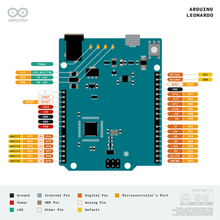The Arduino Leonardo is a microcontroller board based on the ATmega32u4 (datasheet). It has 20 digital input/output pins (of which 7 can be used as PWM outputs and 12 as analog inputs), a 16 MHz crystal oscillator, a micro USB connection, a power jack, an ICSP header, and a reset button. It contains everything needed to support the microcontroller; simply connect it to a computer with a USB cable or power it with a AC-to-DC adapter or battery to get started.
The Leonardo differs from all preceding boards in that the ATmega32u4 has built-in USB communication, eliminating the need for a secondary processor. This allows the Leonardo to appear to a connected computer as a mouse and keyboard, in addition to a virtual (CDC) serial / COM port. It also has other implications for the behavior of the board; these are detailed on the "Getting started with the Arduino Leonardo" guide on the Arduino website.
Tech specs
| MICROCONTROLLER | ATmega32u4 |
| OPERATING VOLTAGE | 5V |
| INPUT VOLTAGE (RECOMMENDED) | 7-12V |
| INPUT VOLTAGE (LIMITS) | 6-20V |
| DIGITAL I/O PINS | 20 |
| PWM CHANNELS | 7 |
| ANALOG INPUT CHANNELS | 12 |
| DC CURRENT PER I/O PIN | 40 mA |
| DC CURRENT FOR 3.3V PIN | 50 mA |
| FLASH MEMORY | 32 KB (ATmega32u4) of which 4 KB used by bootloader |
| SRAM | 2.5 KB (ATmega32u4) |
| EEPROM | 1 KB (ATmega32u4) |
| CLOCK SPEED | 16 MHz |
| LENGH | 68.6 mm |
| WIDTH | 53.3 mm |
| WEIGHT | 20 g |








